
April 05, 2024
Product Scaling: Best Strategies for Growth
As businesses grow, their products often face the challenge of scaling to meet increasing demand and evolving new markets. BCG's recent study on digital proficiency and maturity surveyed about 2,000 global companies. Scaling individual digital solutions can boost revenue by 9% to 25% and save costs by 8% to 28% compared to the baseline. Scaling multiple solutions can lead to an enterprise-wide revenue increase of nearly 17% and a 17% reduction in costs.
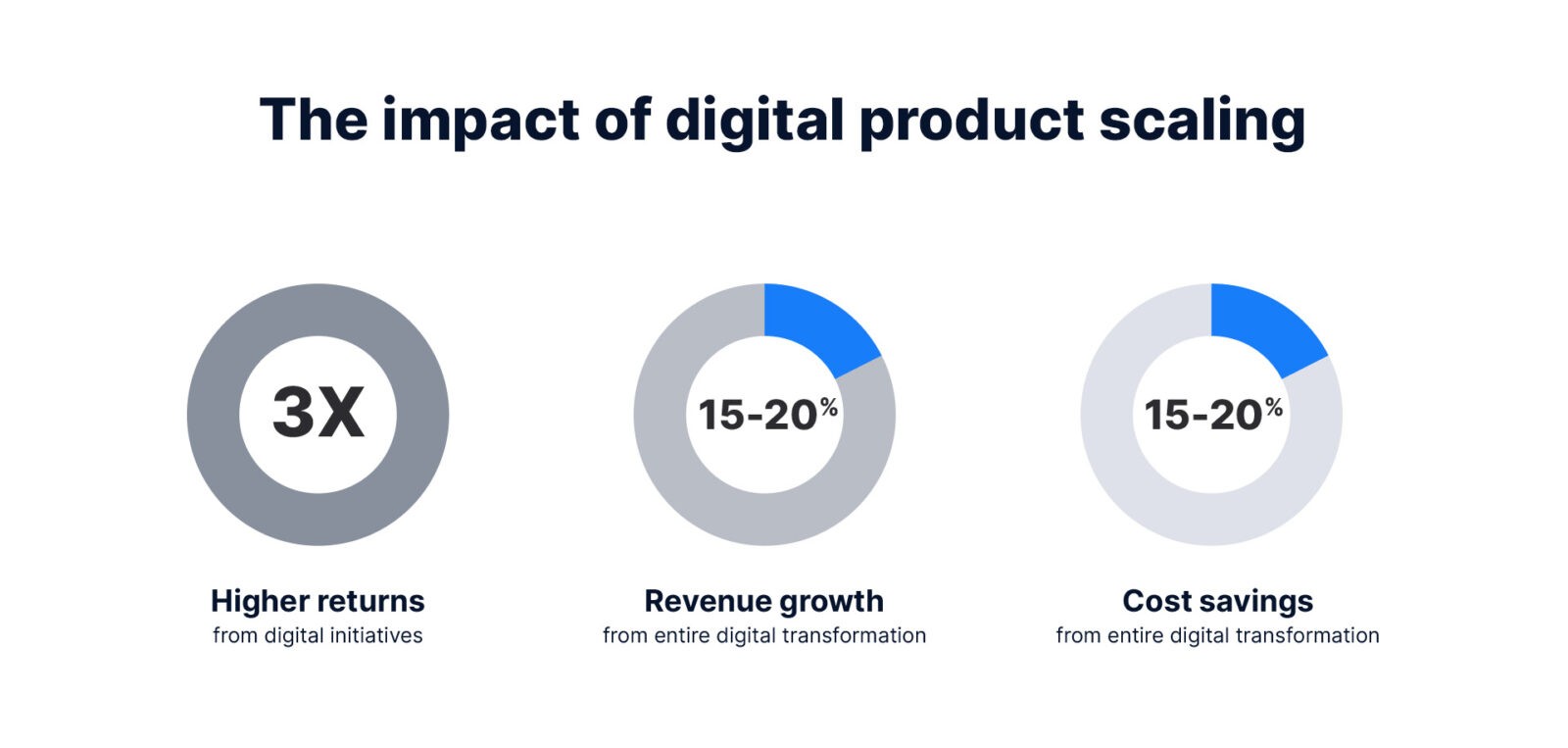
In this article, we explore the best strategies for managing product growth in the software development realm. We'll discuss key indicators that signal the need for scaling and new technologies implementation, steps to prepare for this transition, and effective approaches to product scaling.
From understanding the signs to implementing successful scaling strategies, we'll provide actionable insights to help businesses navigate this crucial phase. Besides, we'll delve into the benefits of scaling and showcase how successful app scaling affects business. Whether you're a startup experiencing rapid growth or an established company seeking to expand your product offerings, this article will equip you with the knowledge and tools necessary for effective and fast scaling.
Top signs that your product requires scaling
Based on our experience with more than 100 unique digital products, we can underline the top 6 reasons and signs that show you need to scale your app or product. Here they are:
- You need to scale from MVP to a full-fledged product according to industry standards
- You’re scaling overall - It happens when your business and customer base are growing and you need to expand your app or product.
- You need to stay ahead of competitors - Scaling offers better performance and new features, ensuring that your digital product can handle increasing demand.
- Poor user experience - As user expectations evolve, scaling up may be necessary to incorporate advanced features, improve the interface, and enhance the overall user experience to retain existing customers and attract new ones.
- Performance issues - Think about scaling when you notice slow load times, frequent timeouts, or system errors. These are all indications that your app is struggling with workload.
- Resources are working at peak (or near-peak) capacity - An infrastructure operating at its limits (for example, at maximum CPU, memory, storage, or network usage) can lead to more frequent downtime and sluggish performance.
How to prepare for product scaling
Based on our experience, the scaling process of an existing business application or digital product requires careful changes to avoid disrupting all project components and functionalities simultaneously, as it can create business-related blockers. In most cases, our clients prefer a customer centric approach that reduces the risk of disrupting the main product functionality already used by users and minimizes the resources needed for testing.
We suggest starting from Technical Audit or Research:
- We conduct stakeholder interviews to gather business requirements and tasks and define scalability goals. Solution architects decompose the project and identify all its components to find bottlenecks.
- We identify limitations and scaling capabilities of each project component (front-end and back-end, communication channels, current infrastructure, storage, third-party services, and integrations), as well as performance and business process bottlenecks.
- Once bottlenecks are identified, tech leads specializing in specific areas and tech stacks analyze code and conduct testing and performance logging.
- Then, we focus on finding targeted solutions for each bottleneck, aiming to solve the problem without affecting the entire system at once. If there are multiple solution options, we outline the pros and cons of each approach and present them to the client.
- Upon client selection of the preferred option, we create a backlog of tasks, prioritize them, and use it to develop a project plan and roadmap. As a result, project work on app/product scaling process begins based on this plan.
Best product scaling approach and strategy
Picking strategy and scaling methods is crucial and usually involves two approaches:
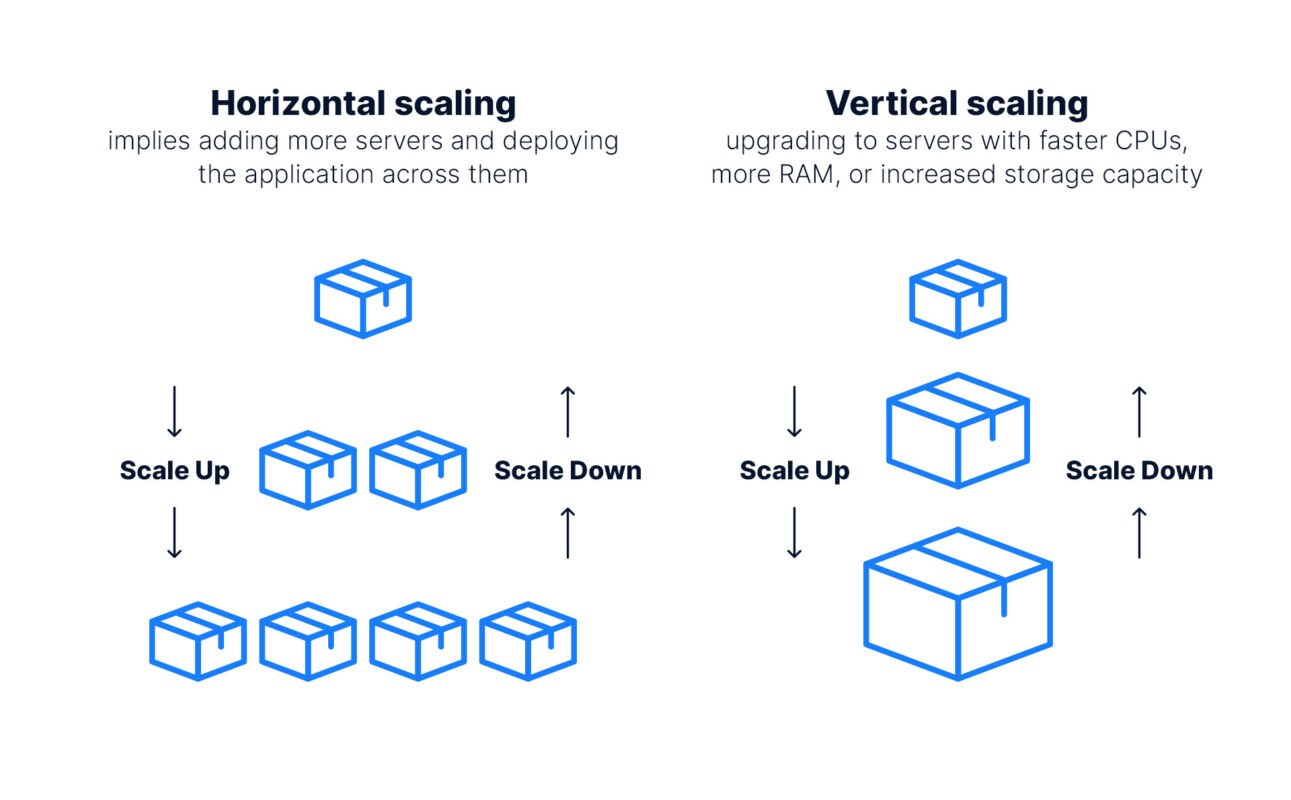
- Vertical Scaling (Scaling Up) - This involves increasing the capacity of individual servers or machines hosting the application, such as by upgrading CPUs, expanding RAM, or enhancing storage. It doesn't require changes in architecture and processes and is resolved through infrastructure modifications.
- Horizontal Scaling (Scaling Out) - This approach entails deploying the application across multiple servers behind a load balancer, distributing concurrent requests evenly. It may involve architectural changes, enhancing the reliability and durability of the entire system.
How to perform product scaling process
Undoubtedly, any digital product scaling starts with strategic planning. In most cases, we scale our clients' digital products in four major steps:
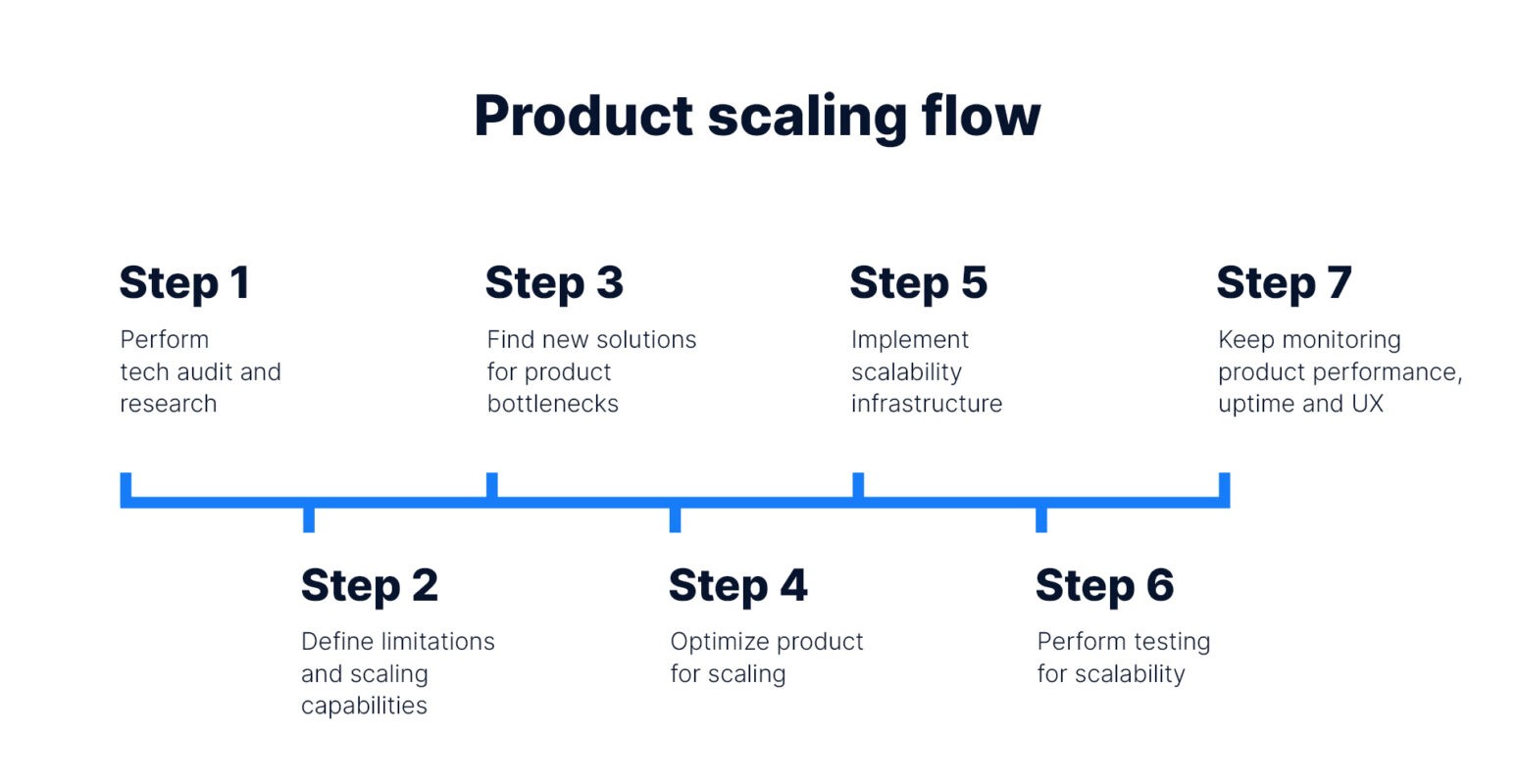
- First, we conduct optimization of an application for scaling. This process includes:
- Refactoring, when you need to modify and optimize the code to improve performance and ensure it can handle increased loads efficiently.
- Decoupling when you need to break down the application into smaller, independent components (like microservices) for easier scaling and maintenance.
- Database Optimization when you need to ensure the database can handle increased queries and transactions.
- Implementing scalability infrastructure that includes:
- Cloud-based Solutions for easier horizontal scaling. Services like AWS, Azure, and Google Cloud offer scalable infrastructure.
- Load Balancers to distribute traffic evenly across servers and prevent any single server from becoming a bottleneck.
- Content Delivery Network (CDN) which is used to reduce latency and improve user experience for geographically dispersed users.
- Testing for scalability that involves:
- Objective, when you need to ensure that the application performs well under various load conditions.
- Process to perform load testing, stress testing, and performance testing.
- Last, but not least. Monitoring and Continuous Improvement. This stage includes:
- Objective that needs continuous monitoring of the application post-scaling to ensure it meets performance benchmarks.
- Process with implementation of real-time monitoring tools to track performance, uptime, and user experience.
- Adjustments to infrastructure, configuration, or code based on the monitoring data.
What benefits does product scaling offer to businesses
Basically, businesses experience 3x higher returns from scaling, up to 20% revenue growth, and 15-20% overall cost savings. At Artkai, we most often observe 6 extra benefits:
- Allows businesses to scale - Scaling a digital product allows businesses to improve their market share and find new customers. A scalable business model is more beneficial in the long run.
- Business agility - Ability to quickly adapt and react to changing market environments and situations.
- Cost savings - Through scaling, businesses can reduce maintenance and operational costs, optimize infrastructure, and make the digital product development process more cost-effective, leading to substantial cost savings for businesses in the long run.
- Improved performance and efficiency - Modernization can significantly enhance the performance and business operations of legacy applications, resulting in quicker response times and improved user experience.
- Increase reliability and resilience - Scaling allows businesses to adapt and grow meeting increasing demand, ensuring continuity and stability in the face of evolving market challenges.
- Better Customer Experience - Modernization often involves revamping the user interface and user experience, contributing to increased customer satisfaction and customer engagement.
How we helped our clients scale their products
Having experience with 100+ digital scalings and software development consulting, we would like to describe two recent projects.
For the first, our development team helped a European telecom company to scale their solution by merging three newly acquired solutions into one cohesive SaaS system, branded as Hub.AI. With numerous stakeholders involved, the project aimed to streamline products seamlessly.
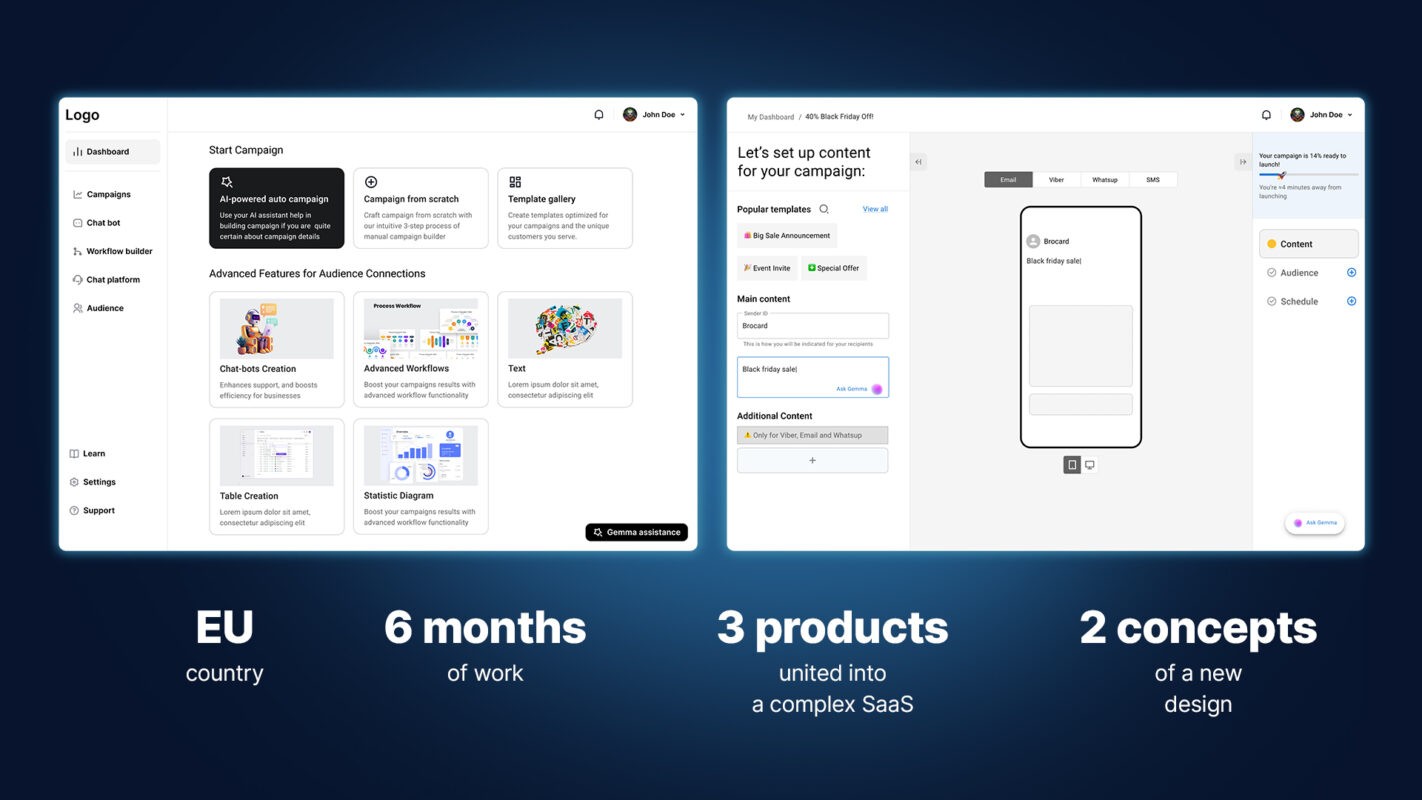
The main challenge of the project was to align the different stakeholders' visions, develop a digital product scaling strategy for the future solution, and meet tight deadlines due to an upcoming marketing event.
We conducted 10 stakeholder interviews and 14 hours of workshops, creating three new customer journey maps and design concepts. Auditing the AI chatbot, campaign builder, and support platform, we defined the vision and requirements for the new platform.
As a result, our dynamic concept, based on real user feedback, ensured improved user flows and functionality. Stakeholders embraced the vision, initiating the next development phase with confidence in our high-end product development plan.
The second project involved working with a unified IoT platform that helps control air quality, humidity, and temperature inside buildings. Artkai’s development team conducted a significant audit and made impressive enhancements to the platform. We added new features, helped enable the connection of additional devices, and facilitated gathering of more data. We made the system more comprehensive while keeping the design user-friendly and intuitive.
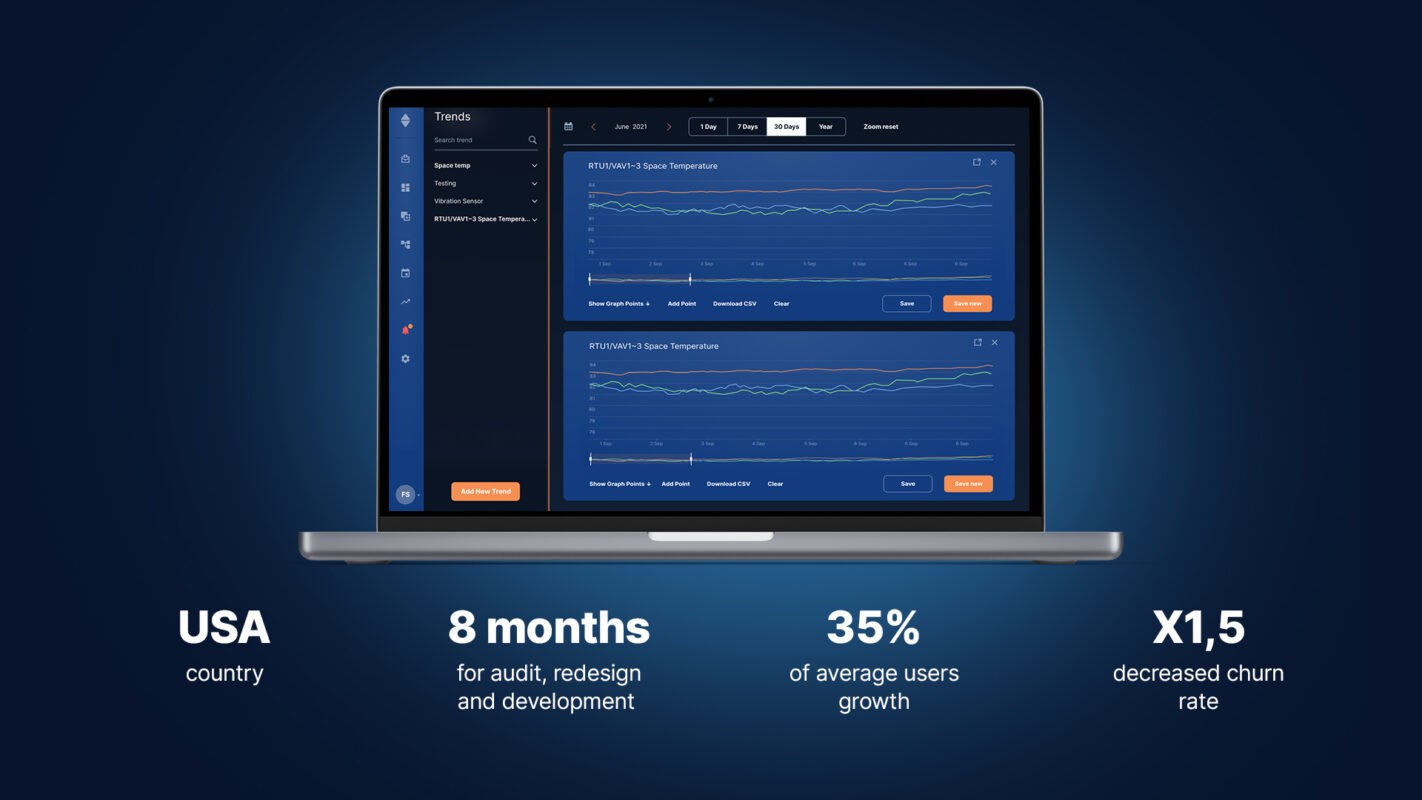
Despite challenges aligning stakeholders' visions and outdated systems, we conducted an eight-month research and design phase, followed by over 12 months of development.
Our strategy included client interviews, persona creation, backlog preparation, and the development of visual concepts and clickable prototypes. Leveraging React, Vue Native, and Node, we redesigned the system's dashboard, enabling customization, plugin integration, and intuitive onboarding.
The improved platform now has open protocol communication, user-friendly dashboards, system schedules, and robust security features. As a result, KMC Commander has become a leading smart building ecosystem, experiencing a 35% increase in average users and a 1.5x decrease in churn rate. Due to efficient scaling, they attract prominent partners like Intel and Amazon.
Wrapping Up
In this article, we've outlined effective strategies for managing scaling in software development. By identifying signs, preparing thoroughly, and implementing smart scaling approaches, companies can expand efficiently and boost their business operations. Product scaling brings numerous benefits, including cost savings, better adaptation to customer needs, and performance enhancements. Our case studies illustrate how scaling improves user flows and functionality resulting in business sustainable growth and increased revenue.
Scaling your product is vital for maintaining competitiveness and meeting evolving customer demands. It's about adapting and growing intelligently. With the right strategies in place, businesses can flourish and achieve remarkable success. If you need our expert consultation about scaling for your business growth, contact us here.
Clients and Results
Schedule your free consultation
Don't miss this opportunity to explore the best path for your product. We are ready to delve into the specifics of your project, providing you with expert insights and optimal solutions.
Book your free sessionRead More
Explore articles from Artkai - we have lots of stories to tell
Join us to do the best work of your life
Together we advance the human experience through design.